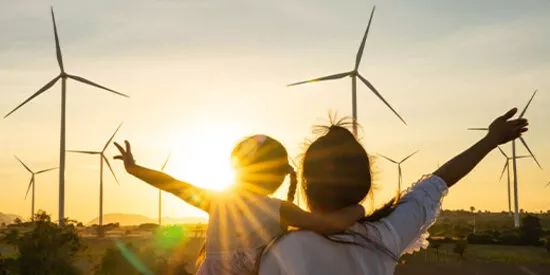
Banking on Japan: Why a sustainable future holds rich opportunities
As Societe Generale celebrates 50 years in Japan, we look ahead at how the energy transition will shape the country’s economic prosperity over the coming decades.
When Societe Generale opened its first branch in Tokyo in 1973, Japan was in the midst of an economic boom that took nominal GDP from US$91 billion in 1965 to US$1 trillion in 1980. Japanese consumer brands were beginning to appear in homes around the world, and the country was cementing its reputation for industrial excellence – especially in electronics and engineering.
Fifty years later, Japan is again at an inflection point as decarbonisation and demographics challenge its established economic model.
The energy transition will be especially challenging for Japan, where mountainous terrain, deep coastal waters and high population density are significant hurdles to the development of solar and wind power. The nuclear power generation hiatus following the Fukushima accident has prolonged the country’s reliance on imported fossil fuels: in 2022, Japan imported nearly 90% of its energy needs with coal representing about a quarter of that consumption.1 The national power grid is not yet capable of accommodating a wholesale shift to renewable energy.
Japan’s economy is also heavily dependent on many hard-to-abate industries: it is the world’s third biggest steelmaker2 and second biggest maritime shipping nation.3 And its manufacturing sector, led by automobiles and their components, accounts for 20% of its GDP – the highest share among the Group of Seven countries.4
We believe, however, that the energy transition is also an opportunity for Japan to consolidate its position at the centre of future supply chains.
Japan’s track record in advanced engineering, its deep financial markets and cohesive decarbonisation policies provide solid foundations for the development of low-carbon business models. By embracing innovation and enhancing its engagement with international investors, Japan can capitalise on the transition to a more sustainable future.
A new approach
Japan’s transition will require new technology, new business models and new financing tools.
Japan is already putting new technology to work. The government has raised its target for renewable energy, which is now projected to make up 36-38% of the energy mix by 2030. It is targeting 45 gigawatts of offshore wind capacity by 2040, and is working hard to attract developers.
Looking further into the future, Japan could also make use of floating bases for offshore wind,5 deep ocean turbines,6 tidal generators, and tap into its vast geothermal resources.
The most exciting technology, however, is green hydrogen, which provides the most viable alternative energy source for heavy industries such as steelmaking, chemicals, shipping and aviation, where electrification is not a practical option. Green hydrogen can also serve as a store of clean energy and can replace fossil fuels in the production of ammonia, fertilizers and other supply chains.
Scaling up the production of green hydrogen would allow Japan to reduce its reliance on imported energy and move the country closer to its net zero ambitions. It would also allow Japanese industry to produce lower-carbon materials and manufactured goods, helping Japan to compete in global supply chains.
Financing the future
Japanese companies certainly have the ambition and ingenuity to realise the country’s energy transition. Its multinational businesses have a history of investing internationally, and are increasingly applying their engineering expertise to critical sectors such as metals and mining, batteries, carbon capture and waste-to-energy infrastructure.
Scaling low-carbon technologies rapidly will require an equally innovative approach to finance. This will include government incentives – at least for an initial period. Japan’s Green Transformation (GX) policy, passed into law earlier this year, allows for this, with a projected ¥150 trillion (US$1.1 trillion) of public and private sector investments over the next decade and plans for ¥20 trillion of GX transition bonds to fund the government’s efforts. Blended finance, where the public purse underwrites a portion of the risk taken by private lenders, could also help innovative business models get started in Japan.
Japan’s liquid and mature capital markets are an advantage. Its infrastructure sector has access to patient investors who are looking for long-term assets, while international investors are showing renewed interest in Japan while the stock market is at multi-year highs.
As one of the world’s leading banks for the energy transition, Societe Generale can support Japanese companies and investors on their sustainability transformation, leveraging both our global experience on innovative transition financings and our deep local knowledge cultivated over the five decades we have operated in Japan.
Societe Generale is the only non-Japanese Bank to have supported the two industry-scale offshore Ishikari windfarm and Akita & Noshiro windfarm projects in Japan and was also financial advisor on the Round 1 tender.
Over the coming decades, our own business model will change as we respond to rising demand for impact-based finance and accompany our clients into new areas. We are working to support breakthrough decarbonisation technologies across the entire energy value chain, through financing and advisory services for a wide range of landmark projects.
Globally, we are supporting the creation of Hy24, the world’s largest dedicated fund for clean hydrogen infrastructure. We have backed landmark battery storage projects in Australia and California. And we are well on our way to our target of mobilising EUR300 billion of sustainable finance from 2022-2025.
As Societe Generale looks ahead to the next phase of economic development in Japan, the group remains focused on working with Japanese corporates and financial institutions to support their growth ambitions. We are excited about the future for Japan and stand ready to support new opportunities – and new business models – as the energy transition gathers pace.
1. https://angeassociation.com/japan-gas-policy-brief/
2. https://worldsteel.org/media-centre/press-releases/2023/december-2022-crude-steel-production-and-2022-global-totals/
3. https://www.offshore-energy.biz/china-is-worlds-leading-shipowning-nation/
4. https://data.worldbank.org/indicator/NV.IND.MANF.ZS?locations=OE
5. https://www.iea.org/commentaries/japan-will-have-to-tread-a-unique-pathway-to-net-zero-but-it-can-get-there-through-innovation-and-investment
6. https://www.bloomberg.com/news/features/2022-05-30/japan-s-deep-ocean-turbine-trial-offers-hope-of-phasing-out-fossil-fuels#xj4y7vzkg

日本のエネルギー・トランジションに向けて「東」と「西」を結ぶ
昨年ソシエテ・ジェネラルがグローバルロードショーの一環として開催した「ポジティブ・インパクト・デー」の東京会場では、日本の脱炭素化政策と国際的なパートナーとしての役割について、最新の動向を踏まえた活発な議論がなされました。

2024年第4四半期および2024年通期決算
パリ、2025年2月6日





